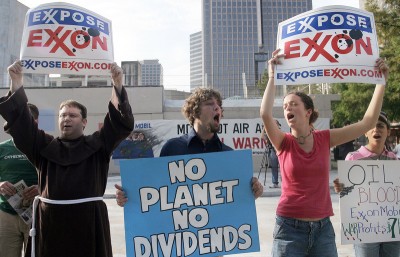Yet another study finds fracking not responsible for GHG emissions rising

Exxon Protest Photo: Greenpeace.
New study illustrates activists’ focus on oil and gas methane emissions is idealistic agenda, not effort to combat climate change
by Seth Whitehead, EnergyInDepth
As environmental activists and the U.S. Environmental Protection Agency (EPA) continue to focus all their attention on methane emissions from oil and natural gas systems, yet another study has been released showing that biogenic sources —virtually ignored by environmentalists in their efforts to “combat climate change”— are actually to blame for the recent increase in global methane emissions.
This new study by researchers from the Department of Earth Sciences at Royal Holloway, University of London, finds a spike in global methane emissions has been “largely driven” by tropical wetlands and agriculture since 2007, as lead author Euan Nisbet explained,
“Our results go against conventional thinking that the recent increase in atmospheric methane must be caused by increased emissions from natural gas, oil, and coal production. Our analysis of methane’s isotopic composition clearly points to increased emissions from microbial sources, such as wetlands or agriculture.”
The study states plainly that its data found “both the majority of this methane increase and the isotopic shift are biogenic.” This is essentially the same conclusion reached by a National Oceanic and Atmospheric Administration (NOAA)/National Institute of Water and Atmospheric Research (NIWAR) study six months ago, and the authors of this new study noted that both studies’ findings “contradict emission inventories.”
One such inventory, the EPA’s latest Greenhouse Gas Inventory, recently used questionable methodology to upwardly revise methane emissions from oil and natural gas production by 34 percent, just ahead of the rollout of the agency’s costly and controversial new regulations on the industry. A recent study by Portland State University also tried to claim oil and gas development is responsible for increased methane emissions, despite failing to explain which specific oil and gas sources are to blame (just one of the study’s numerous flaws). The findings of this study directly refute the EPA and PSU’s findings, further spotlighting the faulty assumptions of each.
Using measurements made by NOAA’s Cooperative Global Air Sampling Network in three locations (the Canadian Artic, the south Atlantic and South Africa), a combination of latitudinal analysis and isotopic data led researchers to determine a majority of the methane increase since 2007 has a biogenic signature, meaning it cannot be attributed to thermogenic methane from oil and gas development.
Unlike the NOAA study, this new study found the increase in methane emissions is more attributable to tropical wetlands rather than agriculture. The researchers note that this could be “in response to changing weather patterns,” including more rain and higher than average temperatures in those regions, particularly in 2014, which saw growth rates of biogenic methane double from the previous year. From the study,
“The isotopic evidence presented here suggests that the methane rise was dominated by significant increases in biogenic methane emissions, particularly in the tropics, for example, from expansion of tropical wetlands in years with strongly positive rainfall anomalies or emissions from increased agricultural sources such as ruminants and rice paddies.”
However, both this new study and the NOAA study rule out oil and gas production as a potential source for the spike in global methane emissions based on the isotopic data collected. From the new study:
“…methane emissions from the majority of large gas and coal fields are characteristically C-enriched relative to the atmosphere and thus not the cause of the observed isotopic shifts.”
“… both the both the latitudinal analysis and isotopic constraints rule out Siberian gas… as a cause of the methane rise, and emissions from other fossil fuel sources such as Chinese coal, US fracking, or most liquefied natural gas are typically more enriched in13C and thus also do not fit the isotopic constraints.”
“Fossil fuel emissions may also have grown, but the sustained shift to more C-depleted values and its significant interannual variability, and the tropical and Southern Hemisphere loci of post-2007 growth, both indicate that fossil fuel emissions have not been the dominant factor driving the increase. A major cause of increased tropical wetland and tropical agricultural methane emissions, the likely major contributors to growth, may be their responses to meteorological change.”
The study further notes that the tropical wetlands are responsible for as much as a quarter of global methane emissions, and that significant weather events — such as La Nina in 2007 and 2008 — could explain a nearly 50 percent hike in methane emissions when compared to last half decade.
This calls into question why environmentalists continue to focus on oil and gas methane mitigation in their efforts to “combat climate change” when study after study shows that the rules would make no significant difference in the big picture.
EID research has found the rule would account for a reduction of a mere 0.0047 degrees Celsius – or four one-thousandths of one degree – by the year 2100. In other words, it would have virtually no impact on the climate.
And considering EPA’s new methane rule could prove to be five times more expensive than the EPA has claimed it would be — threatening to put thousands of small operators of marginal wells already struggling in the current low commodity price environment out of business — the rules don’t make any economic sense, either.
All this said, this new study illustrates once again that activists’ focus on oil and gas methane emissions is more about an idealistic agenda than a genuine effort to combat climate change.
Originally posted on Sept 29, 2016, at EnergyInDepth

Ph: 432-978-5096 Website: www.mapleleafmarketinginc.com








